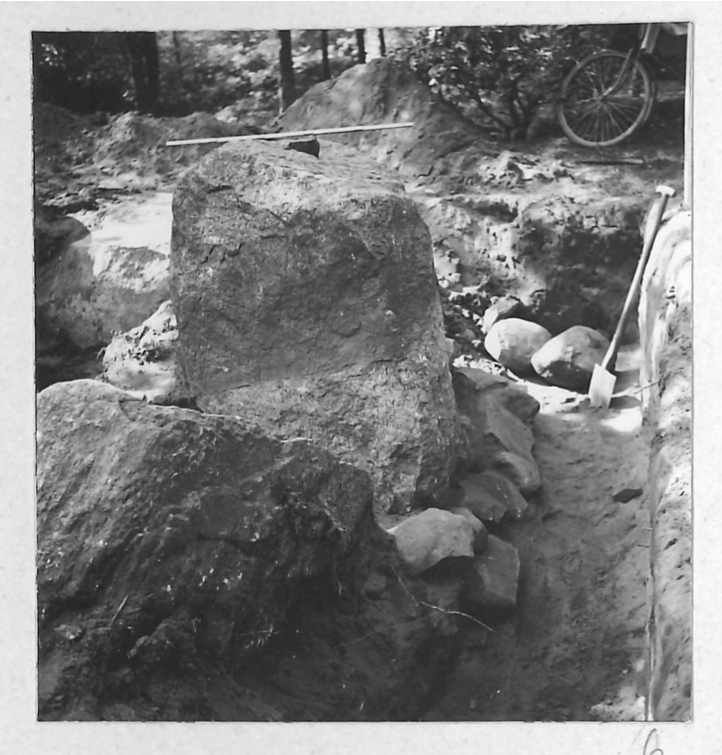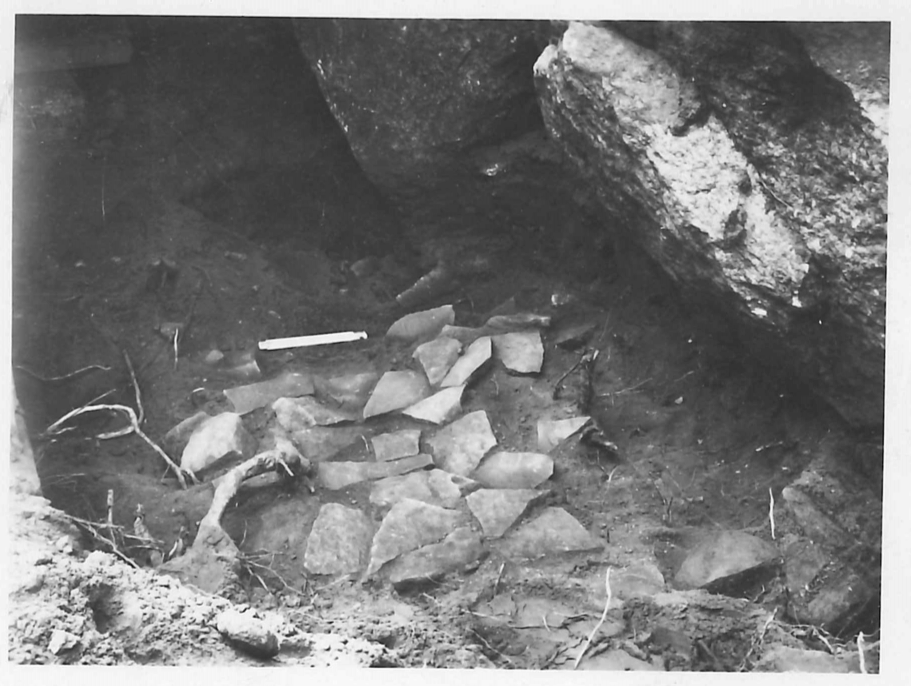
In 1932 the director of the department for prehistory at the State Museum Münster, August Stieren supervised an excavation at the Düwelsteene, which was carried out by the local heritage organisation of Heiden. While the excavation was documented with drawings and photographs, there was no documentation of the Düwelsteene before they started excavating the tomb. This made the citizen science project necessary to get better sources on how the megalithic structure looked before its restoration.
The excavation led to some documentation of the megalithic tomb, with pictures of the excavation itself and images from the excavated inner parts of the tomb, with visible smaller stones lining the floor of the grave. Although the excavation was archaeologically supervised, there are no exact plans or sketches depicting the structure of the megalithic tomb before the excavation and restoration. One sketch that dates to the excavation, displays an idealised plan of the Düwelsteene with placement of the stones after the restoration and the layout of the sections from the excavation.
While the excavation at the megalithic tomb was done by the local heritage organisation of Heiden, it was under archaeological supervision. Because of this we now know, how the tomb was structured and how the megaliths were anchored with smaller flat stones in the sandy ground. It is possible that the megalithic tomb was covered with a hill, because in the drawing of the excavation site smaller megaliths are indicated on the outer area of the tomb. But it is not clear if these smaller megaliths are in situ or were translocated through the destruction of the site to these areas.

Excavation at the Düwelsteene, orthostat on the east side of the tomb (Image: LWL Altertumskommission für Westfalen)
Inside the tomb a 65 cm thick archaeological layer was excavated, which consisted of pottery and bone fragments. In this layer at least three complete pieces of decorated pottery and one undecorated collard flask could be found (Schierhold and Stapel 2018: 8). Because there have been a few excavations at the Düwelsteene at different times, some finds have been lost without any record.
It is possible that Jodocus Hermann Nünning excavated the megalithic tomb in the beginning of the 18th century, but the sherds that he collected and drew in his dissertation are lost. The complete pottery finds and sherds that were excavated in the beginning of the 1920 without any archaeological supervision had been bought in 1930 by the Essener Ruhr Museum, after they had been collected by the innkeeper Hugo Hinsken in Heiden. Heinz Knöll wrote his dissertation in 1959 about these finds from the Düwelsteene, but he didn’t have access to all the sherds, which means his assessment of the pottery finds from the megalithic tomb is incomplete (Schierhold and Stapel 2018: 17).
The vessel shapes that can be identified are funnel beakers, amphorae, collard flasks, bowls and vessels (Schultergefäße) with handles and/or lugs. Completely preserved is one undecorated collared flask and an undecorated amphora (Schierhold and Stapel 2018: 21). From all still existing pottery finds, at least 110 vessels can be identified. Of those identified pottery types, 84 are decorated and 26 are undecorated. Because the Düwelsteene are a relatively known megalithic site, many finds have been lost or destroyed over the centuries through illegal and unrecorded excavations.

Excavation at the Düwelsteene, floor of the megalithic tomb (Image: LWL Altertumskommission für Westfalen)
It can be assumed that the megalithic tomb contained around 300 to 500 vessels. The decorations on the sherds allow a typological classification based on Anna Brindley, which defines horizons 1 to 7 of the funnel beaker culture, as well as new data through radiocarbon dating by Moritz Mennenga. This classification shows an utilisation period of the megalithic tomb from at least 3300 BC to 2860 BC, maybe even until 2760 BC as some pottery finds show typical shapes of these later periods (Schierhold and Stapel 2018: 22). The pottery and decorations as well as the structure of the tomb also corresponds to the classification of the megalithic tomb Düwelsteene to the west group of the Funnel Beaker culture (Jaždžewski 1932: 92 ff).
Unusual are the discoveries of two pits, which were paved with sherds, at the outer part of the megalithic tomb near the boundary of the hill. A similar discovery of such pits was only attested at the excavation of the megalithic tomb of Lengerich-Wechte, north-east of the Düwelsteene near Osnabrück.
- - - - - - - - - - - - - - - - - - - - - - - - - - - -
Sources and further reading: